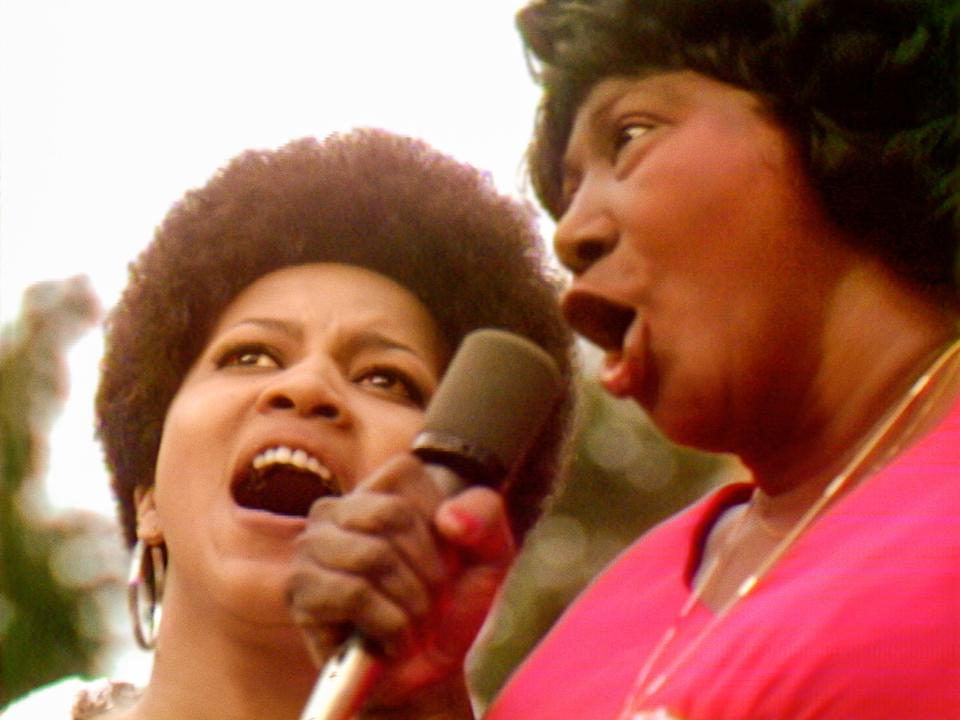Streaming TV: Can you have too much of a good thing? 8 tips to help you trim costs

When we couldn't go hang out with friends, the characters of Netflix's "Bridgerton" kept us company as we settled into stay-at-home shutdown life amid the coronavirus pandemic.
To replace watercooler moments with co-workers, many turned to "The Office," which moved to NBC Universal parent Comcast's Peacock streaming service in January. And since concert venues were closed, we got good vibes from movies like Pixar's "Soul" on Disney+ and "What Drives Us," the documentary directed by Foo Fighters' Dave Grohl about rock bands and their touring vans (on the Coda Collection on Amazon Prime Video).
But now – as life returns to a more familiar version of itself – is it time to cut back on all those streaming services we signed up for?
► Video games: Two-thirds of Americans, 227 million, play them. For many were an escape amid pandemic
► Have an old iPhone? It might not support iOS 15 and you'll miss out on these features

On top of paying for internet connectivity, there's the cost of video services, whether cable, satellite TV, or streaming services – or a combination of both. Like many of us have ourselves, American streaming bills have bulked up a bit since March 2020. Those very generous pandemic special extended free trials have long since expired and now they get tacked on the tab.
It's not uncommon for a household to pay more than $200.
While many homes still pay for traditional pay TV – about 72 million of them in the U.S., according to Leichtman Research Group – top pay-TV providers lost about 4.8 million subscribers over the past year, its research suggests.
"I gave up cable to save money," said Cindy Lum, an employee experience manager in San Francisco. "But now if I want live TV as well, it's just as expensive with all my other subscriptions."
Lum subscribes to Sling TV but is thinking of switching to Hulu Live TV. Still, she plans to give Discovery+ a try and as for Peacock, she said, "I feel like I need it."
Kimbirly Orr of Boulder, Colorado, needs less. "I'm currently reviewing all my subs to pare down."
Her list: AT&T TV, Amazon Prime Video, Netflix, Hulu and Disney+, as well as Sirius XM and Amazon Music. At this point, Orr, executive director of the University of Colorado's Alumni C Club for athletic letter winners, plans to drop live TV as "everything I watch I can find on Hulu."
Do you even know what services you're subscribing to anyway?
If you've lost track of what you have, you're not alone. Streaming bills don't come in the mail; most quietly show up as a charge every month on your credit card.
"It’s a challenge to remember the free trials and auto payments," said Carey Craig, human resources leader from Cheney, Kansas. "Without seeing the monthly costs in the same place at the same time," he said, "the costs creep up."
Craig's family added some new subscription services during the pandemic including Discovery+ to watch Chip and Joanna Gaines' series and Apple TV+ for shows such as "Ted Lasso." (Season 2 is coming out soon, by the way.)
Sure, you may have more services than you expected, but there's so much good stuff to watch in different places.
As Lum put it, "It’s like a buffet where it’s all the same dish but each one is missing one different ingredient so then you have to take all of them to mix it all together to have it be normal."
And there lies the rub: "Choosing which to drop is difficult," said Dennis Gastineau of El Prado, New Mexico, who's settling into retirement and still figuring out what he wants to watch and from where.
During the pandemic, he doubled his streaming subscriptions from three to six – adding Acorn TV, BritBox, and HBO Max to his earlier selections of Hulu, Netflix and Amazon Prime Video. (Couldn't resist "The Flight Attendant" and "Ms. Fisher's Modern Murder Mysteries.")
The typical streaming home had an average of 4.6 services they used and an average of three they paid for, according to Los Angeles-based research firm The Diffusion Group, which surveyed 1,589 U.S. adults. That's up significantly from 2.5 paid services per household in 2019.
And would you believe there are more than 200 streaming services, ranging in price from free (Tubi) to $5 monthly for Peacock Premium (you can pay $5 more to not watch ads) and to more than $60 monthly for YouTube TV ($64.99), which comes with more than 85 live networks including local channels, plus CNN, ESPN, Fox News Channel, MSNBC, TNT and USA.
A streaming customer who subscribed to Netflix, Amazon Prime Video, HBO Max, and the Disney+ bundle (including Hulu and ESPN+), would pay about $52 monthly.
"My opinion is we have drastically underestimated appetite for paying for more subscription services," said Brian Fuhrer, senior vice president of product strategy at Nielsen.
Streaming channels such as Netflix, Hulu and Disney+ now account for 27% of total viewing, Nielsen says. Cable channels such as CNN, ESPN, Fox News Channel, MSNBC and USA, collectively, account for 40%. Broadcast channels such as ABC, CBS, Fox and NBC make up 23%.
► YouTube TV: Download videos and stream in 4K with new 4K TV Plus feature, but it will cost you
► NFL Sunday Ticket: Could Apple TV become its new home? The bidding will kick off soon

Do you have subscription overload?
If you're feeling overwhelmed, you're not alone.
Nearly a third of American consumers say they feel overwhelmed by the number of devices and subscriptions they manage, according to consulting firm Deloitte's survey of 2,009 U.S. consumers in March.
On top of four or five video subscriptions, the average home has two music services and three video game streaming services, said Jana Arbanas, the leader of Deloitte's U.S. telecom, media and entertainment sector.
With consumers finally feeling more comfortable going out to restaurants, movie theaters and concerts, time spent watching videos may fall by half, she said. "I do think there will be a reconsideration of the subscriptions and the content I am looking for from a video perspective."
OK, of course we love our streaming services like @netflix @hulu @disneyplus @PrimeVideo @youtube @hbomax but do you think you have too many? #streaming
— mikesnider (@MikeSnider) July 13, 2021
Need to trim streaming subscriptions? Here's how
"The first step with paring down subscriptions is to check what you have signed up for," said Kimberly Palmer, personal finance expert at NerdWallet. "A lot of consumers signed up for subscriptions during the pandemic that they no longer need, such as streaming and digital subscriptions, particularly for educational content while kids were home from school."
• Check your bank and credit card statements to find those recurring payments, Palmer said. "If there are some listed that you no longer use or don’t even recognize, then call to cancel," she said. Most services make it easy to cancel, but should you hit hurdles in canceling a service, your credit card company can help you cancel the payment or dispute the charge.
• Look for subscriptions that renew annually. "In some ways, those are the hardest to keep track of and it’s easy to forget what we signed up for a year prior," Palmer said. "Opting out of auto-renew is one way to manage those annual subscriptions, so you have to actively opt-in to sign up for another year."
•The next time you sign up for a free trial, make a note in your digital or old-school calendar to cancel it before you start getting billed, she said. "It’s easy to forget otherwise."
• If you want to really assess your streaming situation, you can do what a colleague and her husband told me they did: Put all your services and expenditures into an Excel sheet. They made columns for how much they paid for each and how much they used them.
• There are services such as Truebill and Trim willing to track and assess your bills and subscriptions and attempt to save you money. But they also take a cut of the savings and you must give them your various sign-in credentials, which could deter some potential users.
• Use websites to help you assess whether the content is worth the cost. JustWatch and Reelgood let you plug in the services you have to know what TV and movie content is new, what is coming – and what is on the way out. You can check what's on other services too. (Both have smartphone apps.) By using one of these sites for a month, you could get a handle on each streaming service's value.

• Build it before you buy it. Another site, Suppose.tv, lets you design the ultimate streaming package. You plug in what channels you want and desired features such as a DVR and multiple simultaneous video streams. It recommends the best provider and best price for you, along with special offers that might be available.
• Since streaming services do not require a contract, you can come and go as you please. If you plan appropriately – like making notes in your calendar – you can sign up for a free trial of a service specifically to binge certain content such as a single season of a series, and cancel before your credit card is charged, and then sign up again when the next season hits the service.
"In the current environment, app hopping is not only legally permissible but tacitly encouraged," said Michael Greeson of The Diffusion Group in a recent report. "And while it may be a bit inconvenient to add or drop (subscription video on demand) services on a regular basis, doing so can result in significant cost savings."
During the NFL season, Sam Carolan of Memphis, Tennessee, subscribes to YouTube TV but cancels it for the rest of the year. During the pandemic, he added HBO Max to his list of subscriptions. "I have now collected them all, like Pokémon."
Follow Mike Snider on Twitter: @MikeSnider.
This article originally appeared on USA TODAY: Streaming TV services: Here's how to trim some subscriptions

